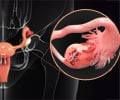Two enzymes called extracellular signal-regulated kinases (ERK1 and ERK2) are critical factors in a pathway that induces ovulation, maturation of the mammalian...
Two enzymes called extracellular signal-regulated kinases (ERK1 and ERK2) are critical factors in a pathway that induces ovulation, maturation of the mammalian egg (oocyte) and other activities key to ovarian function and female fertility, said a group of researchers at Baylor College of Medicine (BCM) in a report that appears today in the journal Science.
"This finding could provide clues to developing new contraceptives and understanding infertility in some women with irregular menstrual cycles," said Dr. JoAnne S. Richards, professor of molecular and cellular biology at BCM and the paper's senior author.Block everything
"There are other genes that when mutated can block ovulation and other activities involved with oocyte maturation or formation of corpora lutea," said Richards and Dr. Heng-Yu Fan, a senior postdoctoral fellow in Richard's laboratory and the paper's first author. "But these are the only ones so potent that they can block everything." (The corpora lutea [luteum in the singular] are a yellow mass of cells that forms from the follicle after the release of an egg. It secretes the hormone progesterone.
Previous studies had shown that mice that lacked ERK1 are viable and can conceive but those without ERK2 died as embryos.
"We thought only one would be important," said Fan.
Enzymes actions are redundant
Advertisement
In women and other female mammals, oocytes exist within the follicles of the ovary, surrounded by granulosa and cumulus cells. Women can only release fertilizable eggs when the follicles grow and the granulose cells differentiate. The oocytes mature and are released through the process of ovulation. Luteinizing hormone (LH) plays a key role in initiating these activities, but this work demonstrates that LH and the canonical pathway it ignites are not the only important elements.
Advertisement
"For a long time, people thought that the canonical pathway involving the luteinizing hormone, cyclic AMP and protein kinase A controls everything. In part, this is true. However, another pathway that involves the signaling protein RAS and ERK1/2 mediates everything downstream of LH-receptor activation," said Richards.
RAS and ERK1/2 are activated "like a bullet," she said, occurring over two hours – just a short but vital period during the entire process of releasing a viable egg.
Source-Eurekalert
LIN














